放射治疗正常组织耐受量限值
第三课 放射治疗质控
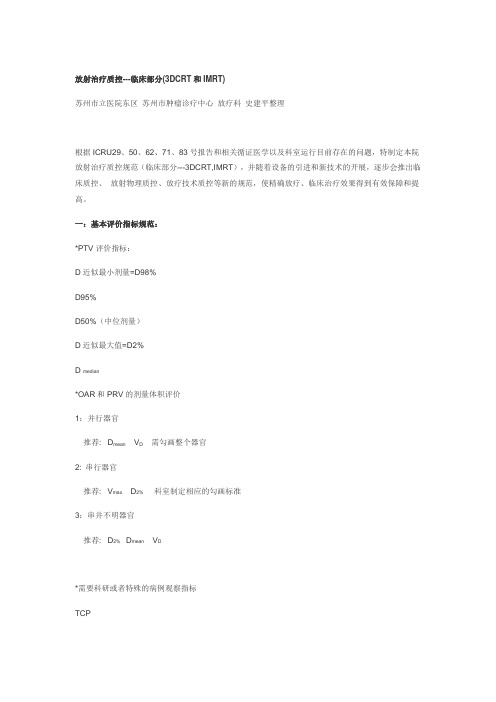
放射治疗质控---临床部分(3DCRT和IMRT)苏州市立医院东区苏州市肿瘤诊疗中心放疗科史建平整理根据ICRU29、50、62、71、83号报告和相关循证医学以及科室运行目前存在的问题,特制定本院放射治疗质控规范(临床部分---3DCRT,IMRT),并随着设备的引进和新技术的开展,逐步会推出临床质控、放射物理质控、放疗技术质控等新的规范,使精确放疗、临床治疗效果得到有效保障和提高。
一:基本评价指标规范:*PTV评价指标:D近似最小剂量=D98%D95%D50%(中位剂量)D近似最大值=D2%D median*OAR和PRV的剂量体积评价1:并行器官推荐: D mean V D 需勾画整个器官2: 串行器官推荐: V max D2%科室制定相应的勾画标准3:串并不明器官推荐: D2% D mean V D*需要科研或者特殊的病例观察指标TCPNTCPEUD(等效均匀剂量)CI*各种体积的定义GTV 肿瘤区CTV 临床靶区PTV 计划靶区OAR S 危及器官PRV 计划危及器官靶区ITV 内靶区TV 治疗区RVR 其他危及体积二:靶区命名规范1:GTV应标明影像手段和放疗剂量T: 肿瘤原发灶, N 淋巴结转移灶例如:GTV-T(Clin,60GY) GTV-T(MRT-T2, 50GY)GTV-N(CT,45GY) GTV-N(PEG-PET,30GY)*鼻咽部用:GTV-NX(* , *)2:CTV和PTV应标明放疗剂量,但不需标明影像手段三:剂量医嘱的规范医生医嘱:提出PTV的D50%处方剂量和特殊的OAR(危及器官)和PRV (计划危及器官靶区)剂量约束的要求★RTOG 0615晶体的剂量限制为最高剂量≤25Gy,RTOG 0225中规定晶体的受量尽可能低,而国内情况,晶体的限量多为最高剂量≤9Gy。
★其他头颈部肿瘤的肿瘤的PRV约束条件参照鼻咽癌(2)胸、腹、盆腔等肿瘤的精确放疗靶区评价和PRV约束条件1、靶区评价:★至少95%PTV满足PTV-D50%(中位剂量或处方剂量)★靶体积内的剂量均匀度95-105%的等剂量线范围内,★PTV的剂量范围在:93-107%PTV 接受<93%的处方剂量的体积<3%PTV 接受>110%的处方剂量的体积<20%★PTV外不出现>110%的处方剂量★出现>TD5/5剂量限值需进行备案登记,由物理师、责任医师和各医疗组长共同讨论并告知决定,杜绝发生>TD50/5事件。
正常组织的耐受剂量
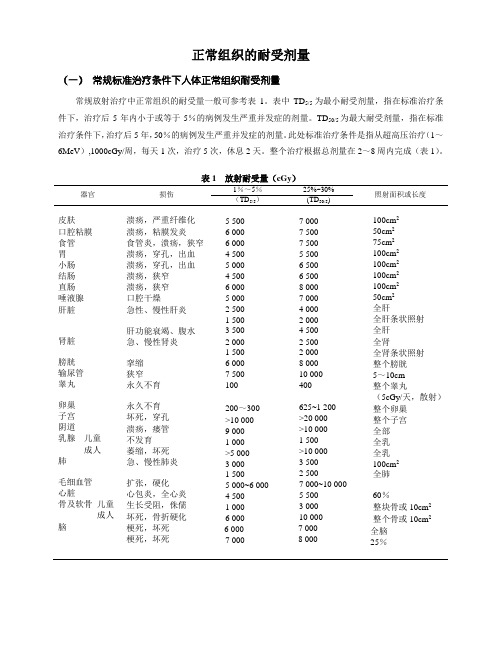
正常组织的耐受剂量(一)常规标准治疗条件下人体正常组织耐受剂量常规放射治疗中正常组织的耐受量一般可参考表1。
表中TD5/5为最小耐受剂量,指在标准治疗条件下,治疗后5年内小于或等于5%的病例发生严重并发症的剂量。
TD50/5为最大耐受剂量,指在标准治疗条件下,治疗后5年,50%的病例发生严重并发症的剂量。
此处标准治疗条件是指从超高压治疗(1~6MeV),1000cGy/周,每天1次,治疗5次,休息2天。
整个治疗根据总剂量在2~8周内完成(表1)。
表1 放射耐受量(cGy)器官损伤1%~5%25%~30%照射面积或长度(TD5/5)(TD50/5)皮肤口腔粘膜食管胃小肠结肠直肠唾液腺肝脏肾脏膀胱输尿管睾丸卵巢子宫阴道乳腺儿童成人肺毛细血管心脏骨及软骨儿童成人脑溃疡,严重纤维化溃疡,粘膜发炎食管炎,溃疡,狭窄溃疡,穿孔,出血溃疡,穿孔,出血溃疡,狭窄溃疡,狭窄口腔干燥急性、慢性肝炎肝功能衰竭、腹水急、慢性肾炎挛缩狭窄永久不育永久不育坏死,穿孔溃疡,瘘管不发育萎缩,坏死急、慢性肺炎扩张,硬化心包炎,全心炎生长受阻,侏儒坏死,骨折硬化梗死,坏死梗死,坏死5 5006 0006 0004 5005 0004 5006 0005 0002 5001 5003 5002 0001 5006 0007 500100200~300>10 0009 0001 000>5 0003 0001 5005 000~6 0004 5001 0006 0006 0007 0007 0007 5007 5005 5006 5006 5008 0007 0004 0002 0004 5002 5002 0008 00010 000400625~1 200>20 000>10 0001 500>10 0003 5002 5007 000~10 0005 5003 00010 0007 0008 000100cm250cm275cm2100cm2100cm2100cm2100cm250cm2全肝全肝条状照射全肝全肾全肾条状照射整个膀胱5~10cm整个睾丸(5cGy/天,散射)整个卵巢整个子宫全部全乳全乳100cm2全肺60%整块骨或10cm2整个骨或10cm2全脑25%续表(二) 局部照射的正常组织耐受量(供常规分次治疗参考)1. 照射1 000~2 000cGy 剂量范围:一些对放射线最敏感的组织受到影响。
常见组织、器官的物理剂量限值
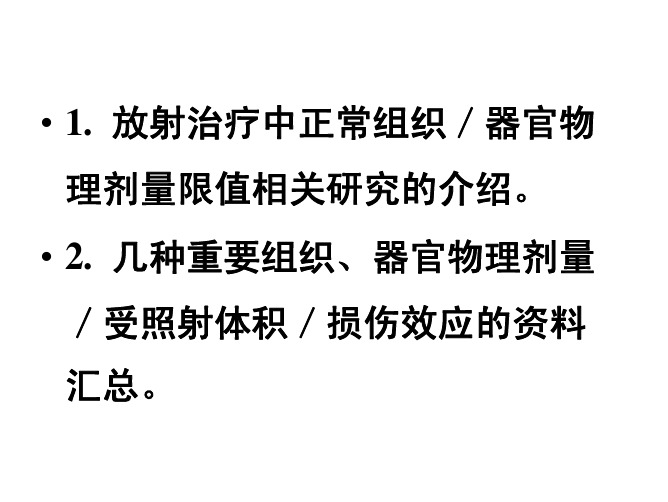
Sharam MS, et al Neurosurgery 63:728–733, 2008
照射体积与治疗 剂量具有同样重 要的作用,尤其 是对于SRS/SRT 而言,脑干单次 12 Gy 即使照射 体积只有0.1 cm3 也会出现临床与 MRI的变化。
剂量--体积效应
观测终点:new symptoms with suggestive radiologic findings。 常规分次总剂量是72Gy 和90Gy 时,生物有效剂量 (BED,α/β 值=3) 分别为120Gy 和150Gy ,损伤的发生率分别是5%和10% 。 每天两次的超分次治疗使得BED在>80Gy时损伤就非常明显。对 于单次 >2.5Gy大分次治疗,发生率与程度难以预测。
在肺、纵隔淋巴结和乳房受照射的病人中,有临床症状的放射
性肺炎(symptomatic pneumonitis)发生率分别为5–50%、
5–10%和1–5%。80%的RP发生在放疗后8个月之内。
晚期毒性评介推荐用LENT-SOMA标准
新的推荐剂量-体积数据
3D-CRT治疗、常规分次、全肺、症状性肺炎
• 1. 放射治疗中正常组织/器官物 理剂量限值相关研究的介绍。
• 2. 几种重要组织、器官物理剂量 /受照射体积/损伤效应的资料 汇总。
1
(1). The WHO Handbook for Reporting Results of Cancer Treatment (1979) (2). Common Terminology Criteria for Adverse Events (CTCAE) by NCI (1988) (3). Acute & Late Radiation Morbidity Scoring System by EORTC/RTOG (1983-1992) (4). LENT SOMA Scales by EORTC/RTOG (1995)
放疗防护

电离辐射防护的关键
(3)辐射源的控制:对辐射源的控制是电离辐射防护的关 键环节。要控制辐射源的质和量。辐射源的活度、能量和 毒性要进行很好的选择,在不影响效果的前提下,尽量减 少不必要的辐射源。近距离开放源的防护对工作人员来说 更重要。从事开放源的操作,不仅对周围人员产生外照射 ,还将构成一种潜在的内照射危害(放射性物质通过呼吸 道、消化道等进入体内)。为加强开放源操作的管理,在 我国的《电离辐射防护与辐射源安全基本标准》中根据所 使用的核素放射性活度和放射性核素的毒性将开放性放射 工作单位分为一、二、三类,并把放射性工作单位内部的 场所划分为甲、乙、丙三级。而在建筑设备、环境布局、 屏蔽隔离等方面施加不同的防护。
——浅谈放射治疗防护 ——浅谈放射治疗的职业防护
黄裕芳
职业防护 放疗防护
一、放射治疗防护的概述
ቤተ መጻሕፍቲ ባይዱ
•(一)、放射治疗的职业危害:主要指引起放射损伤,即一定量的
电离辐射作用于人体后,人体所引起的病理反应。 •(二)、放射治疗防护的目的:防止非治疗性的照射,对接触放 射线的放射工作人员将照射量减少到安全照射量之下。
•(三)、正常安全照射剂量范围:
1、职业性放疗人员全身、晶状体、红骨髓、性腺的照射剂量最大为 5rem、其他器官15rem 2、在工作场所相邻及附近地区工作人员和居民,每年放射限制剂量是 全身、晶状体、红骨髓、性腺的照射剂量最大为0.5rem、其他器官1.5rem 。 3、避免任何情况的暴射。
•(四)、放射损伤的分类 1、全身损伤和局部损伤 2、急性效应和远期效应
2012-6-9
外照射防护:
时间防护、距离防护、和屏蔽防护
• (1)时间防护:就是缩短受照时间。外照射的 受照剂量与受照事件成正比,受照时间越长,所受剂量 越大。因此在不影响工作的原则下应尽量减少工作人员 的受照时间。这就要求工作人员时要有周密的计划,熟 练的操作技术,尽量减少与辐射源的接触时间。如果有 必要,事先应进行空白操作。如果场所剂量较强,一时 又不能用某种方法降低,则可以采用几个人轮流操作, 以减少每个人的受照时间。
正常组织耐受量
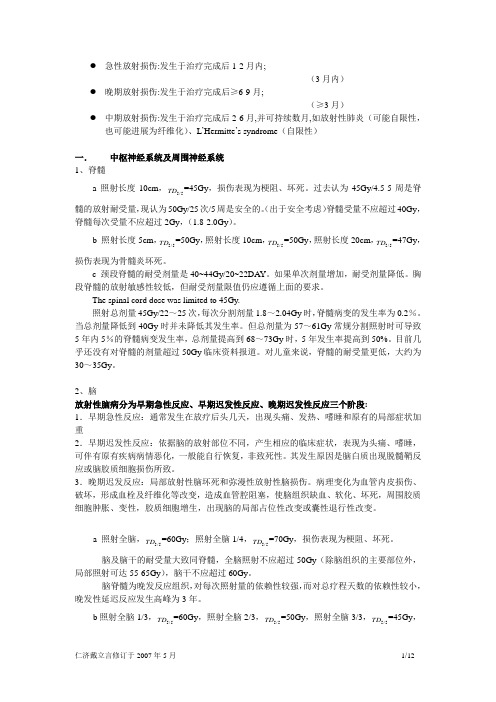
● 急性放射损伤:发生于治疗完成后1-2月内;(3月内)● 晚期放射损伤:发生于治疗完成后≥6-9月;(≥3月)● 中期放射损伤:发生于治疗完成后2-6月,并可持续数月,如放射性肺炎(可能自限性,也可能进展为纤维化)、L ’Hermitte ’s syndrome (自限性)一. 中枢神经系统及周围神经系统 1、脊髓a 照射长度10cm ,5/5TD =45Gy ,损伤表现为梗阻、坏死。
过去认为45Gy/4.5-5周是脊髓的放射耐受量,现认为50Gy/25次/5周是安全的。
(出于安全考虑)脊髓受量不应超过40Gy ,脊髓每次受量不应超过2Gy ,(1.8-2.0Gy )。
b 照射长度5cm ,5/5TD =50Gy ,照射长度10cm ,5/5TD =50Gy ,照射长度20cm ,5/5TD =47Gy ,损伤表现为骨髓炎坏死。
c 颈段脊髓的耐受剂量是40~44Gy/20~22DAY 。
如果单次剂量增加,耐受剂量降低。
胸段脊髓的放射敏感性较低,但耐受剂量限值仍应遵循上面的要求。
The spinal cord dose was limited to 45Gy. 照射总剂量45Gy/22~25次,每次分割剂量1.8~2.04Gy 时,脊髓病变的发生率为0.2%。
当总剂量降低到40Gy 时并未降低其发生率。
但总剂量为57~61Gy 常规分割照射时可导致5年内5%的脊髓病变发生率,总剂量提高到68~73Gy 时,5年发生率提高到50%。
目前几乎还没有对脊髓的剂量超过50Gy 临床资料报道。
对儿童来说,脊髓的耐受量更低,大约为30~35Gy 。
2、脑放射性脑病分为早期急性反应、早期迟发性反应、晚期迟发性反应三个阶段:1.早期急性反应:通常发生在放疗后头几天,出现头痛、发热、嗜睡和原有的局部症状加重2.早期迟发性反应:依据脑的放射部位不同,产生相应的临床症状,表现为头痛、嗜睡,可伴有原有疾病病情恶化,一般能自行恢复,非致死性。
放射治疗时间、剂量分割方式(1)

4.保护肿瘤周围重要器官免受或少受照射,至少不能使 它们接受超过其允许耐受剂量范围的照射,避免产生放射 损伤。
精品医学ppt
6
精品医学ppt
7
二、放射治疗计划中常用的概念
国际放射单位与测量委员会(ICRU)对光子束治疗的处方、记录和报 告规范做了详细的规定,并对三维治疗计划和放射肿瘤学适形放射治 疗技术临床应用的一些基本概念提出了具体规定。
GTV和CTV属于临床解剖学概念,能否正确定义GTV和 CTV依赖于影像学知识,肿瘤病理解剖学知识和临床经验。 它是根据患者的肿瘤分布情况、肿瘤生物学行为在静态影 像(如CT、MR、PET等)上确定的,没有考虑到器官的运 动并与所采用的放射治疗方式无关。
CTV=GTV+1.0cm
精品医学ppt
10
(八)剂量一体积直方图(DVH)
DVH是用于定量描述所定义的体积(如PTV、PORV)内吸 收剂量的三维分布信息。直方图的横轴为吸收剂量,可为 百分剂量或绝对剂量;纵轴为体积,可为百分体积或绝对 体积。DVH的一个重要功能是帮助分析一个治疗计划是否 达到临床治疗的要求,即确定你所关心的结构有多少体积 受到多大剂量的照射;另一个功能是进行治疗计划的比较 和优选,可同时对比两个计划中PTV和PORV所受照射剂 量,在PTV的照射剂量分布相似情况下,选择PORV受到 照射剂量较小的计划。
这种分割方式适用于头颈部的鳞状细胞癌、肺非小细胞癌 等。
超分割放疗能减轻晚反应组织的损伤,大分割放疗相反。 加速放疗则加重急性反应。
精品医学ppt
4
第八节
放射治疗实施过程
精品医学ppt
5
一、临床剂量学原则
《放射性体内治疗药物临床评价技术指导原则》

20232目录一、前言 (1)二、适用范围 (2)三、放射性治疗药物的特点 (2)(一)作用机制 (2)(二)不同放射源的药物作用特点 (3)(三)剂量组成 (5)1、质量剂量 (5)2、辐射剂量学 (6)3、器官耐受剂量限值 (7)(四)安全性特征 (8)(五)辐射防护措施 (9)(六)诊断和治疗的一体化研发 (9)(七)研究中替代显像剂的使用 (10)四、临床试验的设计考虑 (11)(一)首次人体研究(First in Human,FIH) (11)1、研究人群 (11)2、FIH 剂量选择 (11)3、剂量限制性毒性和总体安全性特征 (12)(二)剂量探索研究 (13)1、II 期推荐剂量(Recommended Phase II Dose,RP2D) 的确定 (13)2、给药周期的探索和确定 (14)3、再治疗 (14)(三)关键研究 (14)(四)辐射剂量学 (15)1、方法学 (15)2、辐射剂量学方法的关键指导文件 (16)(五)临床药理学 (17)1、药效学研究 (18)2、药代动力学研究 (18)3、血液和尿液采集和检测的方法学考量 (20)(六)安全性 (22)1、药理学和安全性 (22)2、急性放射毒性 (22)3、特定器官的迟发性毒性 (22)(七)避孕考虑 (23)五、其他应特别关注的问题 (24)(一)辐射防护 (24)1、受试者的辐射安全 (24)2、医护人员的辐射安全 (25)3、环境的辐射安全 (26)(二)跨学科合作及人员培训 (27)(三)联合用药开发的考虑 (29)附:术语表 (30)参考文献 (34)放射性治疗药物是将具有细胞毒性水平的放射性核素选择性地输送到病变部位,利用放射性核素的衰变特征释放射线或粒子对病变细胞产生杀伤作用,从而达到治疗目的的一类药物。
根据给药途径不同可分为系统给药和局部给药,系统给药包括口服或静脉给予的同位素药物(例如碘[131 I]化钠、氯化镭[223Ra]等) ,和放射性配体药物 (例如 lutetium Lu 177 dotatate、lutetium Lu 177 vipivotide tetraxetan 等);局部给药包括植入放射性粒子(例如碘[125 I]密封籽源) 和放射性栓塞微球(例如钇[90Y]微球) 等。
常见组织、器官的物理剂量限值

食管 CTCAE 3.0 版
消化道
分级
不良反应
1
无症状,经病理、影像或内镜发现
2
吞咽困难,主要进软食、半流或流质,静脉补
液小于24小时
3
吞咽困难,需鼻饲或TPN
剂量-体积参考限值
• 对于乳腺癌患者,建议在不影响靶区范围的情况下最大 可能的降低心脏受照射的体积;
• NTCP≥5%可能会抵消/消除放射治疗所获得的生存期 获益;
• V25Gy值<10%(分次剂量2Gy)放疗后15年内的心脏死 亡可能性小于1%;
• HD照射全心剂量限制在30Gy是可接受 ,但联合化疗时 则应将全心剂量限制在~15Gy;
定义食管-体积面临的问题
• 成人食管长度约25-30cm;
• 整个食管的长度上至环状软骨,下至胃食管连接部; • 在计划CT扫描时需包括一部分颈部和上腹部;
• 一些研究没有包括颈部食管,导致食管绝对体积小了 20%;
• 食管周长由于受吞咽活动的影响在CT图像上有明显差 异,因此,传统的DVHs可能并不能准确反映部分的剂 量体积;
RIHD类型
症状
体征
辅助检查
ห้องสมุดไป่ตู้
心包炎
疲劳、劳力性呼吸 腹水、外周水肿、高血压、心 心电图、胸部X线检查、 困难、胸痛、紫绀 包摩擦音、心脏杂音、静脉曲 心脏超声
张、脉搏紊乱、Kussmaul’s征
心肌病变
疲劳、咳嗽、劳力 高血压、短促呼吸、肺部啰音、心 电 图 、 心 脏 超 声 、 放
正常组织的放射耐受剂量
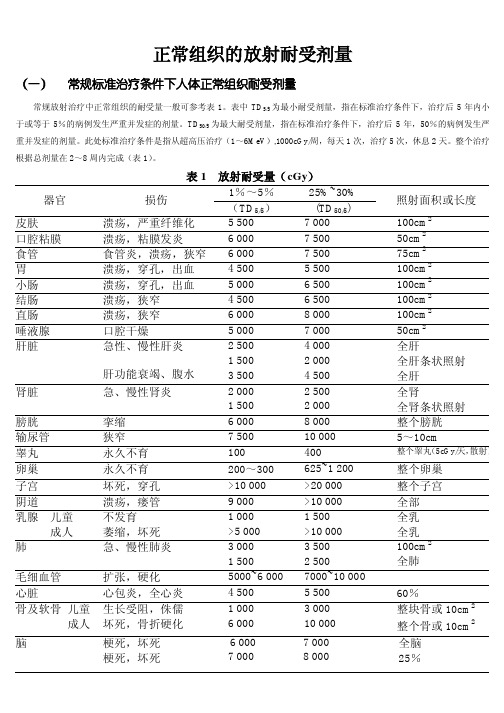
正常组织的放射耐受剂量(一)常规标准治疗条件下人体正常组织耐受剂量常规放射治疗中正常组织的耐受量一般可参考表1。
表中TD5/5为最小耐受剂量,指在标准治疗条件下,治疗后5年内小于或等于5%的病例发生严重并发症的剂量。
TD50/5为最大耐受剂量,指在标准治疗条件下,治疗后5年,50%的病例发生严重并发症的剂量。
此处标准治疗条件是指从超高压治疗(1~6MeV),1000cGy/周,每天1次,治疗5次,休息2天。
整个治疗根据总剂量在2~8周内完成(表1)。
表1 放射耐受量(cGy)1%~5%25%~30%器官损伤(TD5/5)(TD50/5)照射面积或长度皮肤溃疡,严重纤维化 5 500 7 000 100cm2口腔粘膜溃疡,粘膜发炎 6 000 7 500 50cm2食管食管炎,溃疡,狭窄 6 000 7 500 75cm2胃溃疡,穿孔,出血 4 500 5 500 100cm2小肠溃疡,穿孔,出血 5 000 6 500 100cm2结肠溃疡,狭窄 4 500 6 500 100cm2直肠溃疡,狭窄 6 000 8 000 100cm2唾液腺口腔干燥 5 000 7 000 50cm2肝脏急性、慢性肝炎肝功能衰竭、腹水2 5001 5003 5004 0002 0004 500全肝全肝条状照射全肝肾脏急、慢性肾炎 2 0001 5002 5002 000全肾全肾条状照射膀胱挛缩 6 000 8 000 整个膀胱输尿管狭窄7 500 10 000 5~10cm睾丸永久不育100 400 整个睾丸(5cGy/天,散射)卵巢永久不育200~300 625~1 200 整个卵巢子宫坏死,穿孔>10 000 >20 000 整个子宫阴道溃疡,瘘管9 000 >10 000 全部乳腺儿童成人不发育萎缩,坏死1 000>5 0001 500>10 000全乳全乳肺急、慢性肺炎 3 0001 500 3 5002 500100cm2全肺毛细血管扩张,硬化5000~6 000 7000~10 000心脏心包炎,全心炎 4 500 5 500 60%骨及软骨儿童成人生长受阻,侏儒坏死,骨折硬化1 0006 0003 00010 000整块骨或10cm2整个骨或10cm2脑梗死,坏死梗死,坏死6 0007 0007 0008 000全脑25%续表(二) 局部照射的正常组织耐受量(供常规分次治疗参考)1. 照射1 000~2 000cGy 剂量范围:一些对放射线最敏感的组织受到影响。
放射治疗质控

放射治疗质控---临床部分(3DCRT和IMRT)苏州市立医院东区苏州市肿瘤诊疗中心放疗科史建平整理根据ICRU29、50、62、71、83号报告和相关循证医学以及科室运行目前存在的问题,特制定本院放射治疗质控规范(临床部分---3DCRT,IMRT),并随着设备的引进和新技术的开展,逐步会推出临床质控、放射物理质控、放疗技术质控等新的规范,使精确放疗、临床治疗效果得到有效保障和提高。
一:基本评价指标规范:*PTV评价指标:D近似最小剂量=D98%D95%D50%(中位剂量)D近似最大值=D2%D median*OAR和PRV的剂量体积评价1:并行器官推荐: D mean V D 需勾画整个器官2: 串行器官推荐: V max D2%科室制定相应的勾画标准3:串并不明器官推荐: D2% D mean V D*需要科研或者特殊的病例观察指标TCPNTCPEUD(等效均匀剂量)CI*各种体积的定义GTV 肿瘤区CTV 临床靶区PTV 计划靶区OAR S 危及器官PRV 计划危及器官靶区ITV 内靶区TV 治疗区RVR 其他危及体积二:靶区命名规范1:GTV应标明影像手段和放疗剂量T: 肿瘤原发灶, N 淋巴结转移灶例如:GTV-T(Clin,60GY) GTV-T(MRT-T2, 50GY)GTV-N(CT,45GY) GTV-N(PEG-PET,30GY)*鼻咽部用:GTV-NX(* , *)2:CTV和PTV应标明放疗剂量,但不需标明影像手段三:剂量医嘱的规范医生医嘱:提出PTV的D50%处方剂量和特殊的OAR(危及器官)和PRV (计划危及器官靶区)剂量约束的要求★RTOG 0615晶体的剂量限制为最高剂量≤25Gy,RTOG 0225中规定晶体的受量尽可能低,而国内情况,晶体的限量多为最高剂量≤9Gy。
★其他头颈部肿瘤的肿瘤的PRV约束条件参照鼻咽癌(2)胸、腹、盆腔等肿瘤的精确放疗靶区评价和PRV约束条件1、靶区评价:★至少95%PTV满足PTV-D50%(中位剂量或处方剂量)★靶体积内的剂量均匀度95-105%的等剂量线范围内,★PTV的剂量范围在:93-107%PTV 接受<93%的处方剂量的体积<3%PTV 接受>110%的处方剂量的体积<20%★PTV外不出现>110%的处方剂量★出现>TD5/5剂量限值需进行备案登记,由物理师、责任医师和各医疗组长共同讨论并告知决定,杜绝发生>TD50/5事件。
正常器官耐受剂量(常规和低分割)
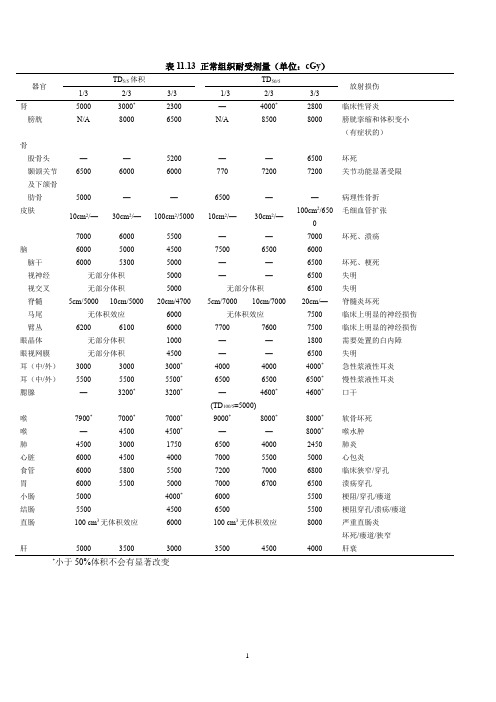
表11.13 正常组织耐受剂量(单位:cGy)器官TD5/5体积TD50/5放射损伤1/3 2/3 3/3 1/3 2/3 3/3肾5000 3000* 2300 —4000* 2800 临床性肾炎膀胱N/A 8000 6500 N/A 8500 8000 膀胱挛缩和体积变小(有症状的)骨股骨头——5200 ——6500 坏死颞颌关节6500 6000 6000 770 7200 7200 关节功能显著受限及下颌骨肋骨5000 ——6500 ——病理性骨折皮肤10cm2/—30cm2/—100cm2/5000 10cm2/—30cm2/—100cm2/650毛细血管扩张7000 6000 5500 ——7000 坏死、溃疡脑6000 5000 4500 7500 6500 6000脑干6000 5300 5000 ——6500 坏死、梗死视神经无部分体积5000 ——6500 失明视交叉无部分体积5000 无部分体积6500 失明脊髓5cm/5000 10cm/5000 20cm/4700 5cm/7000 10cm/7000 20cm/—脊髓炎坏死马尾无体积效应6000 无体积效应7500 临床上明显的神经损伤臂丛6200 6100 6000 7700 7600 7500 临床上明显的神经损伤眼晶体无部分体积1000 ——1800 需要处置的白内障眼视网膜无部分体积4500 ——6500 失明耳(中/外)3000 3000 3000* 4000 4000 4000* 急性浆液性耳炎耳(中/外)5500 5500 5500* 6500 6500 6500* 慢性浆液性耳炎腮腺—3200* 3200* —4600* 4600* 口干(TD100/5=5000)喉7900* 7000* 7000* 9000*8000*8000*软骨坏死喉—4500 4500*——8000*喉水肿肺4500 3000 1750 6500 4000 2450 肺炎心脏6000 4500 4000 7000 5500 5000 心包炎食管6000 5800 5500 7200 7000 6800 临床狭窄/穿孔胃6000 5500 5000 7000 6700 6500 溃疡穿孔小肠5000 4000*6000 5500 梗阻/穿孔/瘘道结肠5500 4500 6500 5500 梗阻穿孔/溃疡/瘘道直肠100 cm3无体积效应6000 100 cm3无体积效应8000 严重直肠炎坏死/瘘道/狭窄肝5000 3500 3000 3500 4500 4000 肝衰*小于50%体积不会有显著改变1表11.15 TG 101报告推荐的正常器官剂量限值23。
正常组织的耐受剂量

正常组织的耐受剂量Newly compiled on November 23, 2020正常组织的耐受剂量(一)常规标准治疗条件下人体正常组织耐受剂量常规放射治疗中正常组织的耐受量一般可参考表1。
表中TD5/5为最小耐受剂量,指在标准治疗条件下,治疗后5年内小于或等于5%的病例发生严重并发症的剂量。
TD50/5为最大耐受剂量,指在标准治疗条件下,治疗后5年,50%的病例发生严重并发症的剂量。
此处标准治疗条件是指从超高压治疗(1~6MeV),1000cGy/周,每天1次,治疗5次,休息2天。
整个治疗根据总剂量在2~8周内完成(表1)。
表1 放射耐受量(cGy)器官损伤1%~5%25%~30%照射面积或长度(TD5/5)(TD50/5)皮肤口腔粘膜食管胃小肠结肠直肠唾液腺肝脏肾脏膀胱输尿管睾丸卵巢子宫阴道乳腺儿童成人肺毛细血管心脏骨及软骨儿童成人脑溃疡,严重纤维化溃疡,粘膜发炎食管炎,溃疡,狭窄溃疡,穿孔,出血溃疡,穿孔,出血溃疡,狭窄溃疡,狭窄口腔干燥急性、慢性肝炎肝功能衰竭、腹水急、慢性肾炎挛缩狭窄永久不育永久不育坏死,穿孔溃疡,瘘管不发育萎缩,坏死急、慢性肺炎扩张,硬化心包炎,全心炎生长受阻,侏儒坏死,骨折硬化梗死,坏死5 5006 0006 0004 5005 0004 5006 0005 0002 5001 5003 5002 0001 5006 0007 500100200~300>10 0009 0001 000>5 0003 0001 5005 000~6 0004 5001 0006 0006 0007 0007 0007 5007 5005 5006 5006 5008 0007 0004 0002 0004 5002 5002 0008 00010 000400625~1 200>20 000>10 0001 500>10 0003 5002 5007 000~100005 5003 00010 0007 0008 000100cm250cm275cm2100cm2100cm2100cm2100cm250cm2全肝全肝条状照射全肝全肾全肾条状照射整个膀胱5~10cm整个睾丸(5cGy/天,散射)整个卵巢整个子宫全部全乳全乳100cm2全肺60%整块骨或10cm2整个骨或10cm2续表(二) 局部照射的正常组织耐受量(供常规分次治疗参考)1. 照射1 000~2 000cGy 剂量范围:一些对放射线最敏感的组织受到影响。
放疗正常器官受量
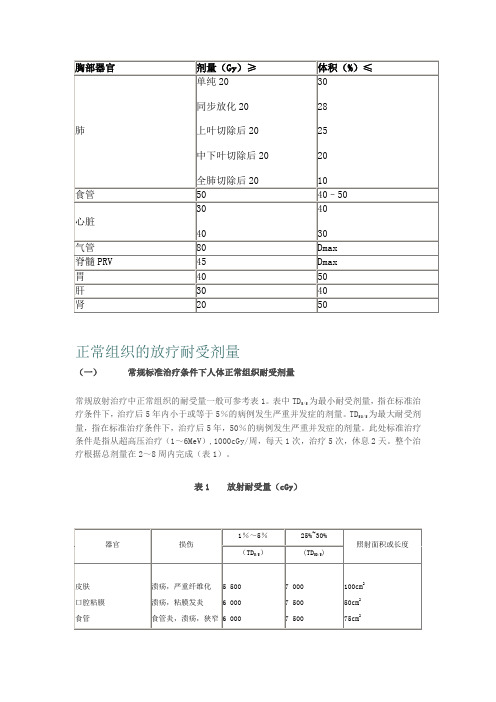
正常组织的放疗耐受剂量(一)常规标准治疗条件下人体正常组织耐受剂量常规放射治疗中正常组织的耐受量一般可参考表1。
表中TD5/5为最小耐受剂量,指在标准治疗条件下,治疗后5年内小于或等于5%的病例发生严重并发症的剂量。
TD50/5为最大耐受剂量,指在标准治疗条件下,治疗后5年,50%的病例发生严重并发症的剂量。
此处标准治疗条件是指从超高压治疗(1~6MeV),1000cGy/周,每天1次,治疗5次,休息2天。
整个治疗根据总剂量在2~8周内完成(表1)。
表1 放射耐受量(cGy)续表(二)局部照射的正常组织耐受量(供常规分次治疗参考)1. 照射1 000~2 000cGy 剂量范围:一些对放射线最敏感的组织受到影响。
生殖腺-卵巢、睾丸的生殖功能丧失。
发育中的乳腺、生长中的骨和软骨有严重的损伤,骨髓功能明显抑制。
大于2 000cGy生长中的骨与软骨完全停止生长,局部骨髓照射后不能再生,晶体浑浊并发生进行性白内障。
胎儿受1 000cGy照射将死亡。
2. 照射2 000~4 500cGy水平的中等剂量范围:整个消化系统、大部分或全部胃、小肠、结肠受此剂量范围的照射后基本不发生严重的并发症。
双侧肾、全肺照射2 500cGy以上即有一定比例发生放射性肾炎及放射性肺炎。
全肝照射4 000cGy以上,发生一定比例的放射性肝炎。
全心照射4 000cGy以上会有心肌受损的可能。
甲状腺、垂体在一定情况下也受到影响,产生功能低下。
生长中的肌肉可以萎缩。
淋巴结受此剂量水平的照射后可萎缩。
3. 照射5 000~7 000cGy剂量范围:皮肤、口腔粘膜、食管、直肠、唾液腺、胰腺、膀胱有1%~5%发生严重并发症。
成熟的骨和软骨、中枢神经系统、脊髓、眼、耳、和肾上腺等器官,如照射较高剂量(7 500cGy)将有20%~50%发生严重损伤。
4. 一般性临床高剂量照射:照射7 500cGy以上不发生严重并发症的有输卵管、子宫、成人乳腺、成人肌肉、血液、胆道、关节软骨及周围神经。
放射治疗正常组织耐受量限值

567What are the recommended dose constraints for the following organs and clinical scenarios?ORGANCONSTRAINTSCNS (1.8–2.0 Gy/fx)Spinal cordm ax 50 Gy (full cord cross-section); tolerance increases by 25% 6 mos after 1st course (for re-irradiation) (QUANTEC)Brain m ax 72 Gy (partial brain); avoidϾ2 Gy/fx or hyperfractionation (QUANTEC)Chiasm/optic nerves max 55 Gy (QUANTEC)Brainstem E ntire brainstem Ͻ54 Gy , V59 GyϽ1–10 cc (QUANTEC)Eyes (globe) M ean Ͻ35 Gy (RTOG 0225), max 54 Gy(RTOG 0615)Lens max 7 Gy (RTOG 0539) Retina max 50 Gy (RTOG 0539)Lacrimal Gland max 40 Gy (Parsons)Inner ear/cochlea m ean Յ45 Gy (consider constraining toՅ35 Gy with concurrent cisplatin) (QUANTEC)Pituitary gland m ax 45 Gy (for panhypopituitarism,lower for GH deficiency) (Emami)Cauda equina M ax 60 Gy (Emami)CNS (single fraction)Spinal cordm ax 13 Gy (if 3 fxs, max 20 Gy ) (QUANTEC)APPENDIXNormal Tissue ConstraintGuidelinesThe radiation dose constraints below are meant to serve as a guide only and may not beapplicable to all clinical scenarios. Most doses are derived from randomized studies or consensus guidelines and we have attempted to provide the sources for these recommendations. Please refer to the individual pediatric chapters for dose constraints in the pediatric population as these can vary greatly from protocol to protocol and tend to be particularly site- and age-dependent.Appendix Normal Tissue Constraint GuidelinesAppendix Normal Tissue Constraint GuidelinesAppendix Normal Tissue Constraint Guidelines。
肿瘤放射治疗技术基础知识-5
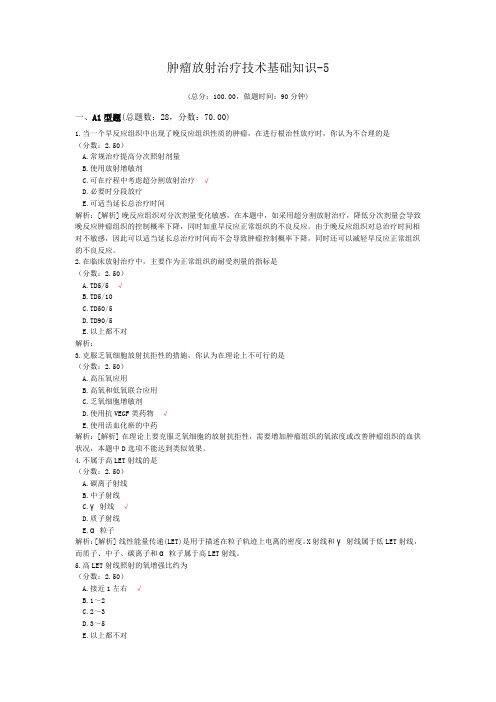
肿瘤放射治疗技术基础知识-5(总分:100.00,做题时间:90分钟)一、A1型题(总题数:28,分数:70.00)1.当一个早反应组织中出现了晚反应组织性质的肿瘤,在进行根治性放疗时,你认为不合理的是(分数:2.50)A.常规治疗提高分次照射剂量B.使用放射增敏剂C.可在疗程中考虑超分割放射治疗√D.必要时分段放疗E.可适当延长总治疗时间解析:[解析] 晚反应组织对分次剂量变化敏感,在本题中,如采用超分割放射治疗,降低分次剂量会导致晚反应肿瘤组织的控制概率下降,同时加重早反应正常组织的不良反应。
由于晚反应组织对总治疗时间相对不敏感,因此可以适当延长总治疗时间而不会导致肿瘤控制概率下降,同时还可以减轻早反应正常组织的不良反应。
2.在临床放射治疗中,主要作为正常组织的耐受剂量的指标是(分数:2.50)A.TD5/5 √B.TD5/10C.TD50/5D.TD90/5E.以上都不对解析:3.克服乏氧细胞放射抗拒性的措施,你认为在理论上不可行的是(分数:2.50)A.高压氧应用B.高氧和低氧联合应用C.乏氧细胞增敏剂D.使用抗VEGF类药物√E.使用活血化瘀的中药解析:[解析] 在理论上要克服乏氧细胞的放射抗拒性,需要增加肿瘤组织的氧浓度或改善肿瘤组织的血供状况,本题中D选项不能达到类似效果。
4.不属于高LET射线的是(分数:2.50)A.碳离子射线B.中子射线C.γ射线√D.质子射线E.α粒子解析:[解析] 线性能量传递(LET)是用于描述在粒子轨迹上电离的密度。
X射线和γ射线属于低LET射线,而质子、中子、碳离子和α粒子属于高LET射线。
5.高LET射线照射的氧增强比约为(分数:2.50)A.接近1左右√B.1~2C.2~3D.3~5E.以上都不对解析:[解析] 随着LET的增高,氧增强比下降。
高LET射线的氧增强比接近于1。
6.对辐射所致细胞死亡的合理描述是(分数:2.50)A.凋亡B.坏死或胀亡C.细胞所有机能和功能的即刻丧失D.细胞增殖能力不可逆的丧失√E.以上都不对解析:[解析] 辐射所致细胞死亡不是指细胞所有机能和功能的即刻丧失,而是细胞失去无限增殖分裂能力,可能有一次或几次有丝分裂,即增殖性死亡。
三维适形放疗中正常组织的损伤和耐受剂量详解

三维适形放疗中正常组织的损伤和耐受剂量Ming Liu, MDProfessor of Radiation OncologyDirector of the Department of Radiation OncologyThe Third Hospital of Hebei Medical UniversityZiqiang Road 139, Shijiazhuang,Hebei, China 050051•模拟机定位平行对穿野照射•照射范围大大超过靶区范围•周围正常组织或是全部器官或是部分器官接受与靶区剂量同样的照射,CT用于模拟定位三维治疗计划靶区体积和靶区周围正常组织的显示更加精确。
多野照射技术,三维显示正常组织的剂量,并且可以通过调整射野参数改变周围正常组织的剂量分布。
早反应组织•细胞更新快,放射后的损伤很快会表现出来,这类组织α/β比值较高,损伤后以活跃的增殖来维持组织中的细胞数量.如:粘膜上皮、骨髓晚反应组织•细胞更新慢,数周甚至一年或更长时间也不进行自我更新,如神经细胞,放射后的损伤很晚才表现出来,这类组织α/β比值较小早晚反应组织的差别组织类型生存曲线的α/β比值对分次量大小的敏感性对治疗总时间的敏感性早反应组织高+++晚反应组织低++++0正常组织的体积效应受照射体积对正常组织耐受性的影响•结构性组织耐受(限定体积内细胞的放射敏感性和使成熟细胞群保持在临界水平以上的干细胞活力)•功能性耐受(作为一个整体的器官是否能继续行使功能)•以器官结构来对体积效应分类,平行组织结构的器官,如(肺、肾)与串联组织结构的脊髓正常组织的体积效应串联组织结构的器官(如脊髓、小肠)•一个功能亚单位的失活便可导致整个器官功能的丧失•这种组织有一个阈值剂量,低于阈值剂量保持正常功能,超过阈值剂量功能丧失•对并发症的风险来说没有一个阈值体积,而是强烈地受非均匀性的热点剂量影响正常组织的体积效应平行组织结构的器官(如肺、肾)•存在着一个照射的阈值体积,超过这个阈值体积,损伤通常表现为程度不同的反应,即随着照射剂量的增大功能性损害的严重性增加•发生并发症的风险取决于在整个器官的剂量分布,而不是小“热点”的存在正常组织的体积效应•不存在纯粹的串联结构组织•平行组织结构的器官内也存在串联结构组织正常组织的体积效应中间型器官结构(脑)•对脑的耐受性而言,与所照射的部位而不是受照射的总体积关系更大,即便是很小区域的照射也会导致其所控制区域特定功能的永久性丧失,但脑的其他功能可能并不受影响脑组织•部分脑组织常规分割照射时,推测产生5%和10%有临床症状的放射性脑坏死的生物有效剂量分别为120Gy和150Gy,相当于每日1次每次2Gy常规照射的剂量72Gy和90Gy•脑组织损伤对>2Gy的分割非常敏感•在研究中发现每日2次的分割同样增加脑组织损伤•脑组织耐受剂量的限定值还缺乏高级别的临床证据,QUANTEC根据现有的数据提出了脑组织耐受剂量的估计值,所以在临床上应用这些限定值应谨慎,需结合临床实际情况给予综合判定•在儿童≥18Gy的全脑照射就会产生认知障碍•脑部肿瘤复发后往往需要再程放疗•一项Meta分析发现脑部再程放疗(2次放疗间隔3-55个月)当总剂量<100 Gy(相当于每次2 Gy的剂量,α/β=2)时未见到脑坏死发生。
正常组织放射治疗耐受剂量

胃
溃疡穿孔出血 4500
小肠ቤተ መጻሕፍቲ ባይዱ
溃疡穿孔出血 5000
7000 100
7500 50 7500 75 5500 100 6500 100
结肠 直肠
溃疡狭窄 溃疡狭窄
4500 6000
6500 100 8000 100
器官
损伤
唾液腺 口腔干燥
1%—5% 25%-30%
TD5/5
TD50/5
5000 7000
肺 急慢性肺炎 3000 3500
100
1500 心脏 心包炎全心炎 4500
2500 5500
全肺 60%
骨软骨 生长受阻 脑 梗塞坏死 脊髓 梗塞坏死 晶体 白内障
1000 6000 4500 500
3000 7000 5000 120
整块骨 25%
10cm 整个/
部分晶体
角膜 角膜炎
5000 >6000 全角膜
正常组织放射治疗耐受剂量
昆明医学院临床肿瘤学院 肿瘤放射治疗中心 李康明
放射治疗的原则?
放射治疗的原则
?在周围正常组织能够耐受的条 件下,提高肿瘤区放射剂量, 以控制肿瘤
最小耐受量(TD5/5) 最大耐受量(TD50/5)
TD5/5:指标准治疗条件下( 1-6Mev , 10Gy/5F/w),治疗 5年后,小于或等于 5%的病例发生严重并发症的剂量;
全睾丸
卵巢
永久不育 200-300 625-1200 全卵巢
子宫
坏死穿孔 10000 20000
全子宫
阴道
溃疡瘘管 9000
>10000 全部
乳腺(儿童) 不发育 1000
(成人)
- 1、下载文档前请自行甄别文档内容的完整性,平台不提供额外的编辑、内容补充、找答案等附加服务。
- 2、"仅部分预览"的文档,不可在线预览部分如存在完整性等问题,可反馈申请退款(可完整预览的文档不适用该条件!)。
- 3、如文档侵犯您的权益,请联系客服反馈,我们会尽快为您处理(人工客服工作时间:9:00-18:30)。
567
What are the recommended dose constraints for the following organs and clinical scenarios?
ORGAN
CONSTRAINTS
CNS (1.8–2.0 Gy/fx)Spinal cord
m ax 50 Gy (full cord cross-section); tolerance increases by 25% 6 mos after 1st course (for re-irradiation) (QUANTEC)
Brain m ax 72 Gy (partial brain); avoid
Ͼ2 Gy/fx or hyperfractionation (QUANTEC)
Chiasm/optic nerves max 55 Gy (QUANTEC)Brainstem E ntire brainstem Ͻ54 Gy , V59 Gy
Ͻ1–10 cc (QUANTEC)
Eyes (globe) M ean Ͻ35 Gy (RTOG 0225), max 54 Gy
(RTOG 0615)
Lens max 7 Gy (RTOG 0539) Retina max 50 Gy (RTOG 0539)Lacrimal Gland max 40 Gy (Parsons)Inner ear/cochlea m ean Յ45 Gy (consider constraining to
Յ35 Gy with concurrent cisplatin) (QUANTEC)
Pituitary gland m ax 45 Gy (for panhypopituitarism,
lower for GH deficiency) (Emami)
Cauda equina M ax 60 Gy (Emami)CNS (single fraction)Spinal cord
m ax 13 Gy (if 3 fxs, max 20 Gy ) (QUANTEC)
APPENDIX
Normal Tissue Constraint
Guidelines
The radiation dose constraints below are meant to serve as a guide only and may not be
applicable to all clinical scenarios. Most doses are derived from randomized studies or consensus guidelines and we have attempted to provide the sources for these recommendations. Please refer to the individual pediatric chapters for dose constraints in the pediatric population as these can vary greatly from protocol to protocol and tend to be particularly site- and age-dependent.
Appendix Normal Tissue Constraint Guidelines
Appendix Normal Tissue Constraint Guidelines
Appendix Normal Tissue Constraint Guidelines。
